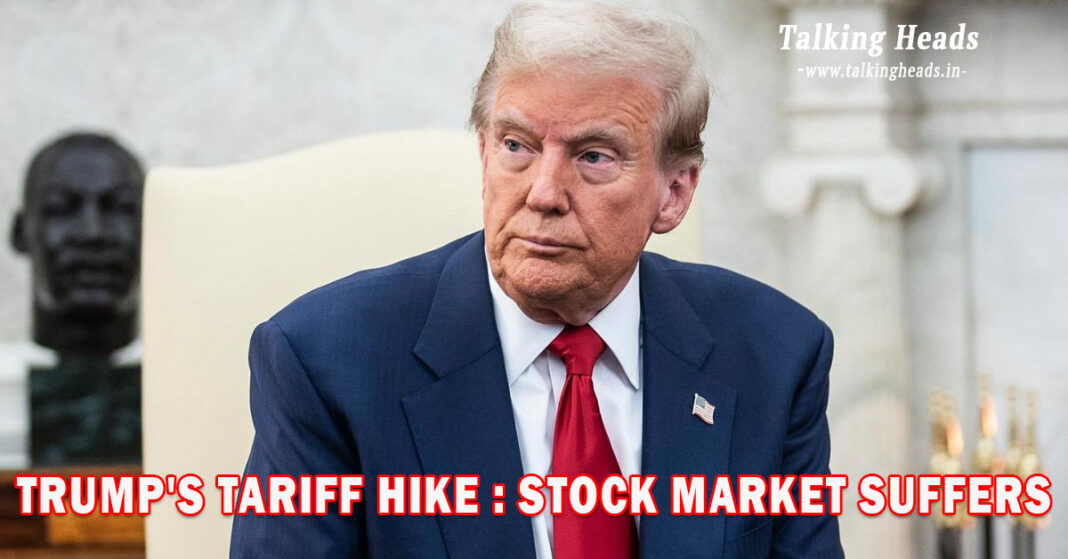Trump’s Tariff Hike : Stock Market Suffers Heavy Losses Amid Tariff Concerns
On February 11, the Indian stock market witnessed a massive crash, with the Sensex plunging 1018 points (1.31%) to close at 76,293. The Nifty also dropped 309 points (1.32%), settling at 23,071. This marks the fifth consecutive trading session of market decline.
Table of Contents
Sectoral Indices Reflect Market Weakness
Among sectoral indices, Nifty Realty took the biggest hit, falling by 3%, while the Media Index closed 2.85% lower. Other significant losses were recorded in Auto, FMCG, Pharma, and PSU bank indices, each shedding nearly 2%. The Metal and IT indices also faced sharp declines, closing 1.50% lower.
The broad-based sell-off in the stock market wiped out ₹9.27 lakh crore of investor wealth. The total market capitalization of BSE-listed companies stood at ₹408 lakh crore on February 11, down from ₹417 lakh crore on February 10.
Trump’s Tariff Hike :Three Key Reasons Behind Market Crash
1. Trump’s Tariff Hike Sparks Trade War Fears
Market volatility intensified following former U.S. President Donald Trump’s decision to raise tariffs on steel and aluminum imports. The move has rekindled global trade war fears, impacting investor sentiment. Trump increased aluminum tariffs from 10% to 25% and reinstated a 25% tariff on steel imports, which were previously duty-free in the U.S.
2. Foreign Institutional Investors (FIIs) Exit Indian Markets
Foreign institutional investors (FIIs) have been aggressively selling Indian stocks. As of February 10, FIIs had offloaded ₹12,643 crore worth of stocks in the cash segment. Since October, they have collectively sold over ₹2.75 lakh crore in the Indian equity markets, contributing to the downward trend.
3. Weak Q3 Earnings Disappoint Investors
Disappointing third-quarter (Q3) earnings have further dampened market sentiment. Eicher Motors’ stock, for instance, fell 7% post-earnings. While the company reported a 17.5% year-on-year increase in net profit to ₹1,170.5 crore for Q3FY25, the figure fell short of market expectations. Rising costs and weaker sales of high-margin motorcycles impacted profitability.
Mixed Performance in Asian and Global Markets
Asian markets showed a mixed trend amid global uncertainties:
- South Korea’s KOSPI gained 0.71%.
- Hong Kong’s Hang Seng Index fell 1.06%.
- China’s Shanghai Composite Index dropped 0.12%.

Foreign investors continued to sell aggressively, with FIIs offloading shares worth ₹2,463.72 crore on February 10, while domestic institutional investors (DIIs) bought ₹1,515.52 crore worth of equities.
Meanwhile, U.S. markets remained resilient:
- Dow Jones closed 0.38% higher at 44,470.
- S&P 500 gained 0.67%, ending at 6,066.
- Nasdaq Composite advanced 0.98%.
Stock Market Decline Extends for Fifth Straight Session

On February 10, the Sensex had already declined by 548 points, closing at 77,311. The Nifty also fell 178 points to end at 23,381. Out of the 30 Sensex-listed stocks, 24 ended in the red, while only six managed to gain.
Sectors such as energy, IT, and metals bore the brunt of selling pressure. Notably, Tata Steel and Power Grid stocks declined by 3% each, contributing to the overall market weakness.
Market Outlook: Caution Prevails Amid Global Uncertainty
With global trade tensions on the rise and persistent FII outflows, market volatility is expected to continue. Analysts recommend cautious trading, emphasizing long-term investment strategies to navigate ongoing uncertainties.
Investors should closely monitor global macroeconomic trends, corporate earnings, and policy changes to make informed decisions in the current unpredictable market environment.










